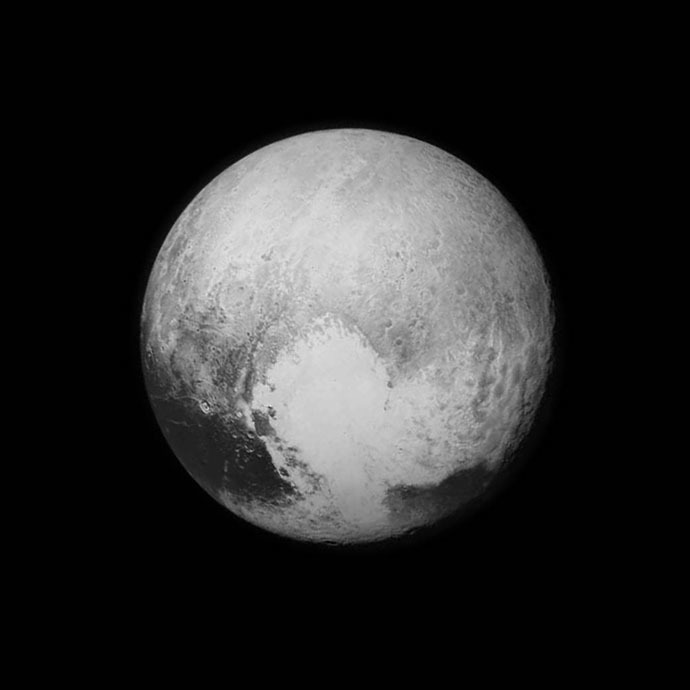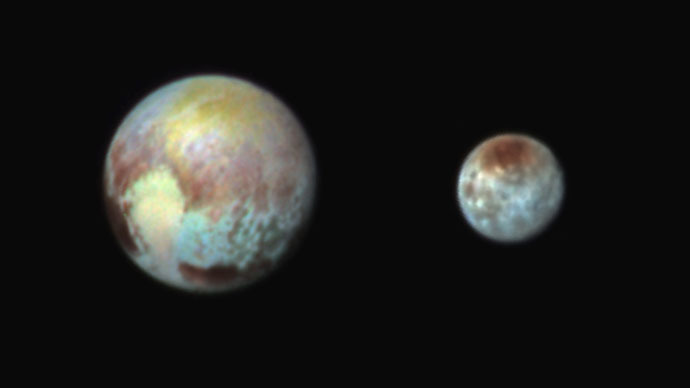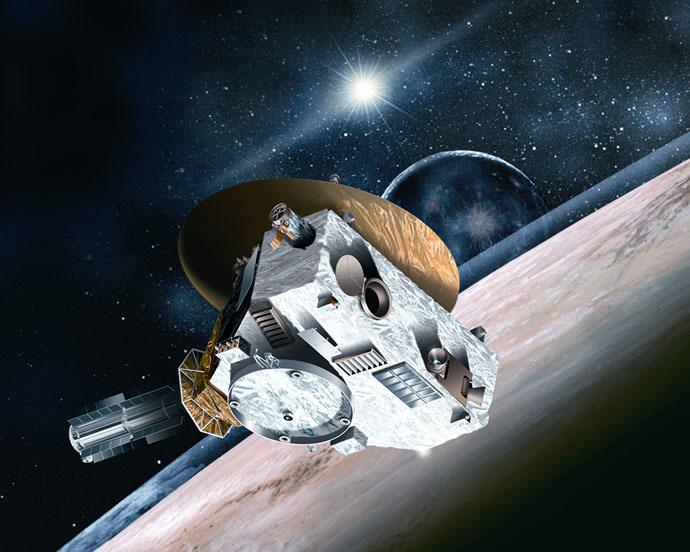3,500m icy peaks of Pluto: NASA reveals striking images of dwarf planet (PHOTOS)

NASA’s New Horizons spacecraft has sent back to Earth the amazing and detailed photos of Pluto and its satellite Charon for the first time. They turned out to be far from dull balls of ice, with high mountains and deep canyons.
On July, 14 the spacecraft New Horizons made the closest flyby to Pluto, having passed only 12,500 kilometers (7,750 miles) above the dwarf planet on the outskirts of the solar system. The first transmitted photos have already led to some incredible discoveries.
Zoom into Pluto & discover mountains, seen during yesterday's @NASANewHorizons#PlutoFlyby: http://t.co/6QLXLxiW0ohttps://t.co/toJQ0j7wB6
— NASA (@NASA) July 15, 2015
The world has been discussing a “heart” on the Pluto’s surface but even more intriguing areas proved to lie just to the south of that. The images revealed by NASA’s historic press conference on Wednesday showed mountains in the equatorial region which are as high as 3,500 meters (11,000 feet) and are about 100 million years old.
“This is one of the youngest surfaces we’ve ever seen in the solar system,” said Jeff Moore of the New Horizons Geology, Geophysics and Imaging Team (GGI) at NASA’s Ames Research Center in Moffett Field, California.

The scientists said that the processes which created those mountains differ from those that built mountains on icy satellites of giant planets – Pluto can’t be heated by gravitational interactions with a bigger planet since it’s only orbiting the distant Sun.
“This may cause us to rethink what powers geological activity on many other icy worlds,” said GGI deputy team leader John Spencer.

Photos of Charon also provided astronomers with new material for further researches. The Pluto’s satellite has a swath of cliffs and troughs – about 1,000 kilometers (600 miles) long. That may be the result of geological process on Charon.
The Pluto’s biggest satellite also has a canyon which is thought to be seven to nine km (four to six miles) deep.
Hydra, Pluto's potato-shaped moon is 27 miles (43 km) by 20 miles (33 km). Thanks #PlutoFlybyhttp://t.co/EQZ44AfSYwpic.twitter.com/YrAmrmhv7T
— NASA New Horizons (@NASANewHorizons) July 15, 2015
The gathered data also reveal that Pluto’s Charon is more cratered that the dwarf planet. Scientists are now scratching their heads for the reasons behind it.
“We’re not quite sure yet. It’s possible that more active internal geologic processes on Pluto are causing the surface to erode and recycle itself more rapidly,” said Alan Stern New Horizon’s principal investigator during a briefing on Wednesday.

“Or it’s possible that atmospheric processes are covering up some of Pluto’s craters. When we get more data back, we’ll be able to piece this mystery together,” he added.
Today, the @NASANewHorizons team is bringing what was previously a blurred point of light into focus. pic.twitter.com/AswUMZFxqd
— NASA (@NASA) July 15, 2015
NASA’s New Horizons spacecraft also took first ever images of four smaller moons of Pluto: Nix, Hydra, Styx and Kerberos. Hydra appeared to have irregular shape and be about 43 by 33 km (27 by 20 miles). The satellites’ surfaces might be coated with ice.

Further photos are likely to provide the scientists with a deeper understanding of the formation of Pluto’s four small satellites.

It took NASA’s spacecraft more than nine years to reach Pluto after it was launched from Cape Canaveral on January, 19, 2006. It traveled more than three billion miles to reach the dwarf planet on the outskirts of our solar system which was discovered in 1930 and puzzled the scientists ever since.

After the Pluto flyby the New Horizons will travel further into a region of space known as the Kuiper belt, which lies beyond the planets and mostly contains frozen remnants from the Solar System's formation.












